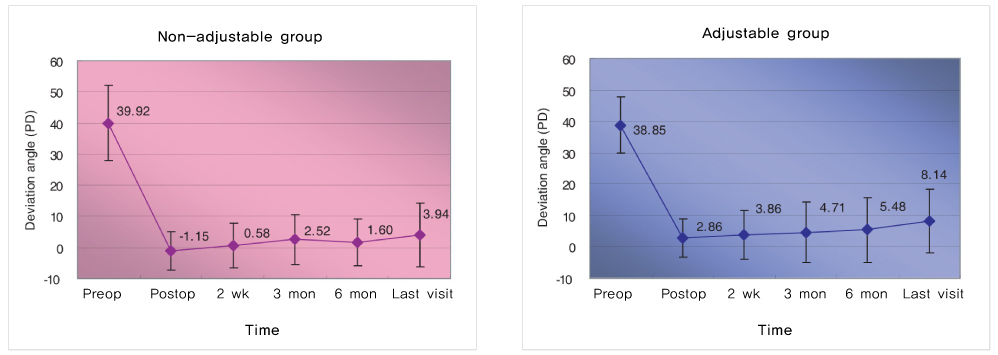Korean J Ophthalmol.
2009 Dec;23(4):277-280. 10.3341/kjo.2009.23.4.277.
Comparison of the Stability of Postoperative Alignment in Sensory Exotropia: Adjustable Versus Non-Adjustable Surgery
- Affiliations
-
- 1Department of Ophthalmology, Kyungpook National University School of Medicine, Daegu, Korea. byjun424@hotmail.com
- KMID: 754763
- DOI: http://doi.org/10.3341/kjo.2009.23.4.277
Abstract
- PURPOSE
To compare the success rates and stabilities of postoperative alignment between adjustable and the non-adjustable surgeries in the treatment of sensory exotropia.
METHODS
A retrospective analysis was performed on all patients with sensory exotropia who had undergone unilateral lateral rectus recession and medial rectus resection (R&R) between January 1998 and August 2005. Thirty-four patients underwent conventional R&R, and 20 patients underwent R&R with adjustable suture of the lateral rectus. The surgical results between the two groups were analyzed with regard to the preoperative and post-operative deviation angles and the postoperative drift. The postoperative deviation angle was measured on postoperative day 1 as well as at two weeks, three months, six months and the final visit after surgery.
RESULTS
There were no statistically significant differences in the mean preoperative and postoperative deviation angles between the two groups. In 30 (88%) patients in the non-adjustable group and 15 (75%) patients in the adjustable group, postoperative deviation was less than 15 prism diopters (PD) at the three month follow-up. There was no significant difference in the mean postoperative drift between the two groups.
CONCLUSIONS
Strabismus surgery with adjustable sutures did not show a significantly better result than surgery without adjustable sutures in the treatment of sensory exotropia. Considering the amount of postoperative exodrift in both groups, we postulate that the immediate ocular alignment after surgery for sensory exotropia should be orthophoric or 5-6 PD of esodeviation.
Keyword
MeSH Terms
Figure
Reference
-
1. Rosenbaum AL. The use of adjustable suture procedures in strabismus surgery. Am Orthopt J. 1978. 28:88–94.2. Wisnicki HJ, Repka MX, Guyton DL. Reoperation rate in adjustable strabismus surgery. J Pediatr Ophthalmol Strabismus. 1988. 25:112–114.3. Lennerstrand G. Adjustable sutures in strabismus surgery: a follow-up study. Acta Ophthalmol. 1982. 60:717–728.4. Weston B, Enzenauer RW, Kraft SP, Gayowsky GR. Stability of the postoperative alignment in adjustable-suture strabismus surgery. J Pediatr Ophthalmol Strabismus. 1991. 28:206–211.5. Jampolsky A. Current techniques of adjustable strabismus surgery. J Pediatr Ophthalmol Strabismus. 1979. 88:406–418.6. Hertle RW. Clinical characteristics of surgically treated adult strabismus. J Pediatr Ophthalmol Strabismus. 1998. 35:138–145.7. Bishop F, Doran RM. Adjustable and non-adjustable strabismus surgery: a retrospective case-matched study. Strabismus. 2004. 12:3–11.8. Tripathi A, Haslett R, Marsh IB. Strabismus surgery: adjustable sutures-good for all? Eye. 2003. 17:739–742.9. Walters G, Stewart OG. Bradbury JA. The use of subtenon ropivacaine in managing strabismus with adjustable sutures. J AAPOS. 2001. 5:95–97.10. Parks MM, Mitchell P. Duane TD, Jaeger EA, Tasman W, editors. Concomitant exodeviations. Clinical Ophthalmology. 1988. v. 1:revised ed. Philadelphia: Harper & Row;chap. 13.11. Mohan K, Ram J, Sharma A. Comparison between adjustable and non-adjustable hang-back muscle recession for concomitant exotropia. Indian J Ophthalmol. 1998. 46:21–24.12. Keech RV, Scott WE, Christensen LE. Adjustable suture strabismus surgery. J Pediatr Ophthalmol Strabismus. 1987. 24:97–102.13. Eino D, Kraft SP. Postoperative drifts after adjustable surgery. Can J Ophthalmol. 1997. 32:163–169.14. Pratt-Johnson JA. Adjustable suture strabismus surgery: a review of 255 consecutive cases. Can J Ophthalmol. 1985. 20:105–109.15. Park HY, Jung SK, Nam KR. Surgical results of adjustable strabismus surgery in horizontal rectus muscles. J Korean Ophthalmol Soc. 1996. 37:1335–1341.
- Full Text Links
- Actions
-
Cited
- CITED
-
- Close
- Share
- Similar articles
-
- Surgical Results of Adjustable Strabismus Surgery in Horizontal Rectus Muscles
- Adjustable Suture Technique in Pediatric Strabismus with Ketamine Anesthesia
- The Effect of Bilateral Superior Oblique Tenotomy on Primary Position Horizontal Alignment
- A Case of Adjustable Surgery in Wall-eyed Bilateral Internuclear Ophthalmoplegia after Head Trauma
- A Case of Reinforced Adjustable Fadenoperation


